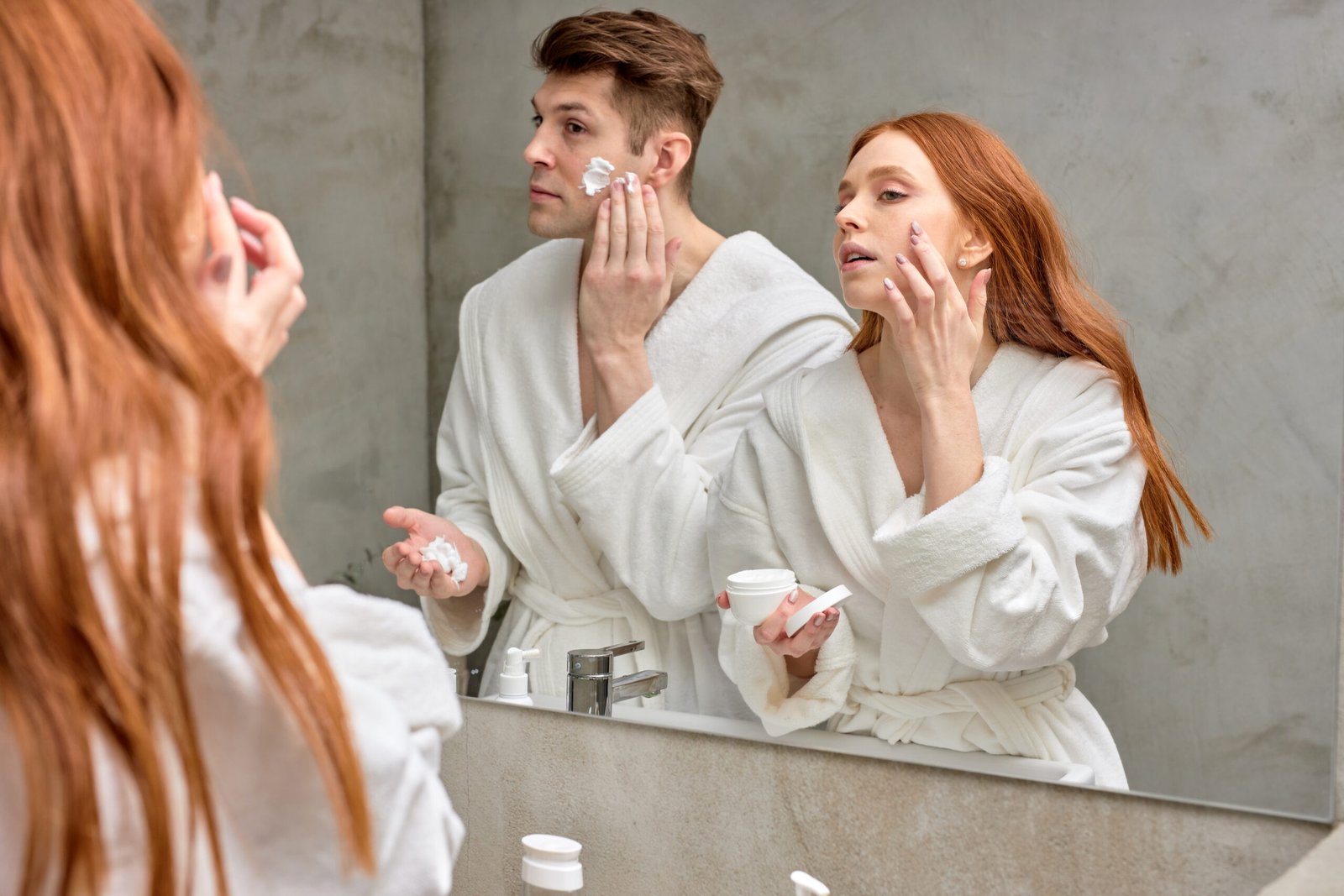Acne is a prevalent skin condition, with up to 95% of people in the UK experiencing some form of acne in their lifetime. But, the development of acne isn’t split 50/50 between men and women. Research shows that men are more likely to develop acne in their teenage years when going through puberty. In contrast, women are more likely to develop adult acne – which is defined as developing acne around age 25 and over.
What causes acne?
Before we get into the differences between acne in men and women, we need to understand what causes acne in the first place. There are four main factors in the development of acne in both men and women, they are:
- Excess oil production (usually from a hormonal imbalance)
- Excess keratinisation (a build-up of dead skin cells in the pore)
- Bacterial imbalances (An overgrowth of C.acnes)
- Inflammation
These factors happen directly within the skin, and there’s one hormone that can contribute to all four factors – testosterone.
Now although testosterone is always thought of as a male hormone, both men and women produce testosterone. The biggest difference is that men have much higher levels of testosterone compared to women. When boys go through puberty, their levels of testosterone increase rapidly to help with their development into adulthood.
The role of testosterone in acne
In both men and women, there are numerous sebaceous glands throughout the body. These are tiny glands found in the skin that produce oil (sebum) which helps to hydrate and protect the skin. The largest sebaceous glands are found on the face, neck, chest, shoulders and back.
The sebaceous glands within the skin are sensitive to androgens (hormones such as testosterone). So, when testosterone levels increase, it can trigger the sebaceous glands to produce more oil. This increase in oil production encourages the growth of C. acnes, which feeds on oil within the pore. When C. acnes increases rapidly, it triggers inflammation within the pore which leads to the development of acne. Because boys have such a rapid increase in testosterone during puberty, they are more likely to experience acne in their teens compared to women.
Acne can still continue in both men and women after puberty, which is then known as adult acne. The statistics around how common adult acne is are mixed, but it’s estimated that around 3% of men struggle with adult acne. Whereas around 80% of the cases of adult acne occur in women.
Is acne always caused by testosterone?
If men have higher levels of testosterone naturally, shouldn’t 80% of adult acne occur in men, not women? Well, that’s where it gets a little more complex. Everyone is really quick to blame testosterone for the development of everyone’s acne. But, not everyone with acne will actually have testosterone issues. Remember those four main drivers of acne?
That’s just looking at the surface.
If we were to dive deeper into what causes those four main drivers, you’d find these:
Excess oil production
We briefly discussed how the sebaceous glands are sensitive to testosterone, so if someone has oily skin and acne, we automatically think it’s a testosterone issue. But, an increase in cortisol can affect the sebaceous glands, too. In fact, stress is finally being identified as a cause of acne.
Chronic stress can affect our bodies in a few ways, from throwing off the balance of hormones, depleting our bodies of nutrients and interfering with the balance of digestion and the gut microbiome.
Another common cause of increased oil production within the skin is using the wrong skincare. If your skin is feeling clean and tight after you cleanse, you’re stripping the skin barrier. In response to this, the skin produces more oil to try and rebalance itself – making your skin feel ‘greasy’, ‘shiny’ or oily. In a similar fashion, dehydration can trigger the skin to produce more oil.
It’s important to be aware that certain medications can also trigger the sebaceous glands – such as steroid medications. These medications are synthetic versions of cortisol.
Excess keratinisation
This process is essentially how well your skin exfoliates itself. In healthy skin, skin cells are created at the base of the skin, and they move upwards and eventually shed off. However, in acne – this process is slowed down, meaning skin cells aren’t shedding off correctly and they become stuck in the pore. Imbalances in keratinisation have been linked to inflammation and high levels of insulin. Insulin levels can increase if we’re eating a high amount of refined carbohydrates and sugars, and low amounts of fibre, protein and healthy fat. Insulin can also start to increase overtime due to lack of sleep, low amounts of exercise and stress.
Bacterial imbalances
In acne, the bacterial imbalance is linked more so to C. acnes, and that’s why antibiotics are often recommended either topically or orally. Antibiotics have been found to help reduce the growth of acne-causing bacteria and have mild anti-inflammatory effects.
But, have you ever thought about why you might have an overgrowth of bacteria in the first place? Bacterial imbalances can arise from using the wrong skincare (which throws off the balance of the skin microbiome), a diet low in fibre and high in refined carbohydrates and sugars, stress, certain medications and antibiotic use. When we have increased amounts of beneficial bacteria on the skin, it helps to reduce the growth of acne-causing bacteria and keeps everything in check.
Inflammation
Research has shown that people with acne have higher levels of systemic inflammation – that means within the whole body, not just topically on the skin. When it comes to regulating inflammation, we need to find out what’s annoying your immune system in the first place, and what’s adding fuel to the fire? It can be a few things (some of which we have already mentioned). Causes of low-grade, chronic inflammation include:
- Lack of sleep
- Stress
- A diet low in fruits, vegetables and nutrients
- Sedentary lifestyles
- Infections (viral/bacterial)
- Nutrient deficiencies
- Gut imbalances
- Food intolerances
- Hormone imbalances
- Blood glucose issues and high insulin
- Alcohol
- Smoking
- Skin picking
Hopefully, this has helped to highlight that it’s not always just a testosterone issue. And, unfortunately, if we have all of these underlying imbalances, most of us won’t grow out of our acne.
When it comes to treating acne in men or women, it’s actually the same. There are biological differences between men and women, but the underlying causes of acne in both are the same. To help clear acne naturally in men or women, we need to find what’s causing any of those four main drivers within the skin. The biggest difference is that men don’t have the same hormonal fluctuations as women do throughout the months and their lifetime.
Why do women get acne more than men?
That being said – why do women have more adult acne than men? Well, it can be down to the hormonal changes that women experience.
The hormone factor
The biggest change in men’s hormones happened during puberty. After that, testosterone in men follows a daily cycle – having peaks and dips throughout the day. It doesn’t really change dramatically, in fact, there’s more of a gradual decline in testosterone as men age. Whereas women’s hormones change considerably throughout the month, during pregnancy and transitioning through menopause.
Some women also have hormonal conditions such as PCOS, or Endometriosis which can affect the balance of hormones, and make it a little more difficult to regulate the skin. As well, a lot of women take some form of hormonal contraception throughout their life, which can affect both their bodies and skin in a variety of ways.
Because of these hormonal changes in women, hormonally driven adult acne can be a little more complicated than what we see in men. But, some researchers do suggest that adult acne in both men and women should be considered in the same way as chronic disease, with multiple factors playing a role.
The 10-step skincare routines
Another factor that may be affecting women is that they tend to use more beauty products than men. Now while it might sound like a good thing, using too many products, or the wrong skincare products can strip and damage the skin barrier. When the skin barrier becomes damaged it can increase the risk of developing skin conditions. In this case, acne isn’t being caused by a hormonal component, it’s being triggered by inflammation caused by bad skincare. This is the complete opposite to the myth that acne is caused by dirty skin. In these cases, acne is caused by being too clean.
How to clear acne naturally in men and women
While there may be slight differences in hormonal cycles between the sexes, the underlying factors in acne remain the same. To help clear acne naturally, we have to find the underlying drivers and correct those, which will then help to balance those four main drivers of acne.
You can find out more about private testing here, but if you need help on your journey to healthy skin, please feel free to contact me so we can chat about how nutritional therapy may be able to help you.





0 Comments